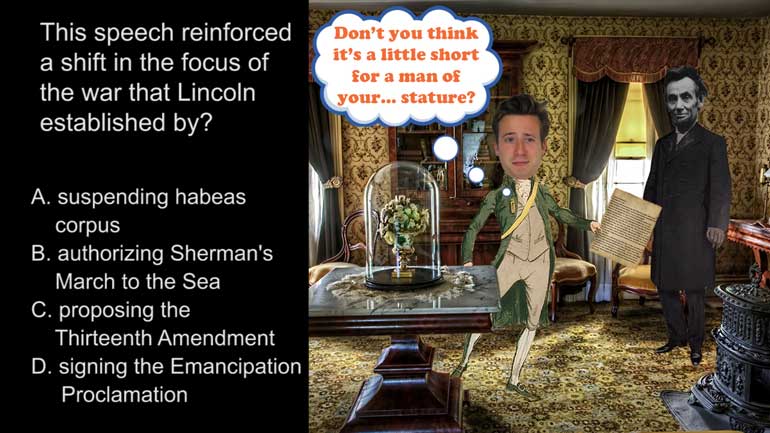ShmoopTube
Where Monty Python meets your 10th grade teacher.
Search Thousands of Shmoop Videos
AP U.S. History 2.1 Period 4: 1800-1848 308 Views
Share It!
Description:
AP U.S. History 2.1 Period 4: 1800-1848. Harriet Robinson describes an economic shift characterized by all of the following except for what?
Transcript
- 00:00
[ musical flourish ]
- 00:03
And here's your Shmoop du jour, brought to you by the spinning jenny,
- 00:07
the dizziest girl on the block.
- 00:09
All right, take a look at the excerpt.
- 00:10
In almost every... [ mumbles ]
Full Transcript
- 00:13
[ mumbling continues ]
- 00:17
And the question: Harriet Robinson describes
- 00:19
an economic shift characterized by
- 00:21
all of the following except for... what?
- 00:24
And here are your potential answers.
- 00:25
[ bell dings ]
- 00:29
What exactly is the economic shift described in the excerpt?
- 00:32
Well, first off, that title,
- 00:34
Life among the Early Mill Girls,
- 00:36
means we're talking about the Industrial Revolution
- 00:38
in the U.S. where goods were all of a sudden
- 00:40
made in factories rather than by hand in the home.
- 00:43
We also see the cotton factory described as a great opening
- 00:46
for women, where they could earn money
- 00:48
and spend it as they pleased.
- 00:50
So we've got women working outside the home and earning their own wages.
- 00:53
Talk about a tectonic shift. We just need to figure out
- 00:56
which of these answers does not describe
- 00:58
that same societal earthquake.
- 01:00
So was this economic shift during the Industrial Revolution
- 01:03
characterized by A - a decrease in subsistence farming?
- 01:07
Well, with the arrival of industrial factories,
- 01:09
women started leaving the small subsistence farms
- 01:12
owned by their families to go work for factories in the big city,
- 01:15
which led to a big increase in urban populations.
- 01:18
So we can say good-bye to both A and B.
- 01:20
Could the economic shift have been characterized by C -
- 01:23
a growing reliance on technological innovation?
- 01:26
Well, you bet. All those new inventions:
- 01:28
the spinning jenny, the spinning mule, the waterframe,
- 01:31
they all allowed production to be centralized in factories.
- 01:35
Not quite as cool as an iPhone, but still pretty revolutionary.
- 01:37
So it can't be C.
- 01:38
Which means that the economic shift wasn't characterized by
- 01:42
D - a relaxation of the strict social and moral codes
- 01:44
imposed upon women.
- 01:45
Yes, women did make big advances by entering
- 01:48
these new factory jobs.
- 01:49
They were earning their own money and living away from home,
- 01:51
a degree of freedom many women had never before experienced.
- 01:55
Except that freedom wasn't actually
- 01:57
very, well, free.
- 01:59
Younger girls were seen as vulnerable to
- 02:01
the temptations of urban life,
- 02:03
so they had to live in company housing
- 02:05
where older women supervised their every move.
- 02:07
So the correct answer is D.
- 02:09
And not that they'd have a chance to succumb to temptation
- 02:12
during the grueling 80-hour work week.
- 02:14
But apparently staying away from
- 02:16
sweets really is a full-time job.
- 02:19
[ bird sounds ]
Up Next
AP U.S. History Exam 2.45. The journey shown on the map was an example of...what?
Related Videos
AP U.S. History Exam 2.26. This speech reinforced a shift in the focus of the war that Lincoln established by...what?
What did the Spanish messengers bring with them to North America? Hint: you probably wouldn't be thrilled to get this for your next birthday.
AP U.S. History Diagnostic 24. How did the United States choose containment over the National Security Council Report in Latin America?
AP U.S. History Exam 2.25. In writing the Gettysburg Address, Lincoln was still working to win over Northern voters who believed that...what?




